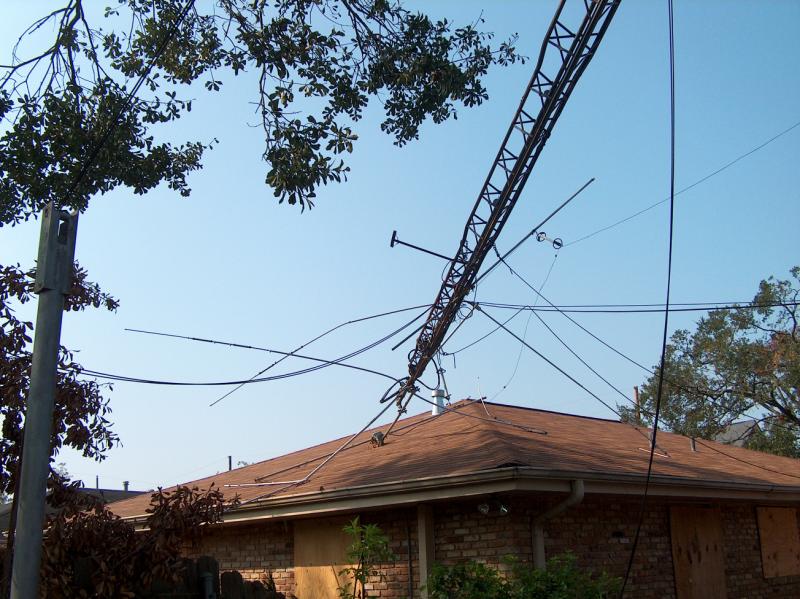
Hurricane Katrina Damage to the HF Antennas at W5JGV - WC2XSR/13
by W5JGV
On August 28, 2005, Hurricane Katrina virtually destroyed New Orleans, Louisiana.
Among the more fortunate survivors were W5JGV and KB5YSE - our QTH was only moderately damaged. However, the LF and HF antenna systems at W5JGV were thoroughly trashed by Katrina. The following photos will give you an idea of some of the storm damage.

This is the scene that greeted us when we were finally able to return to our home some four weeks after Katrina. My 65 foot tower had collapsed and fallen on to my next-door neighbors roof. The remains of the TH3-jr tri-band beam are spread awkwardly across the rooftop.

When the tower collapsed, the rotor that switched the two-meter Yagi from horizontal to vertical polarization punched a hole in the roof. When I removed the remains of the beam and tower, I installed a temporary patch over the damaged area
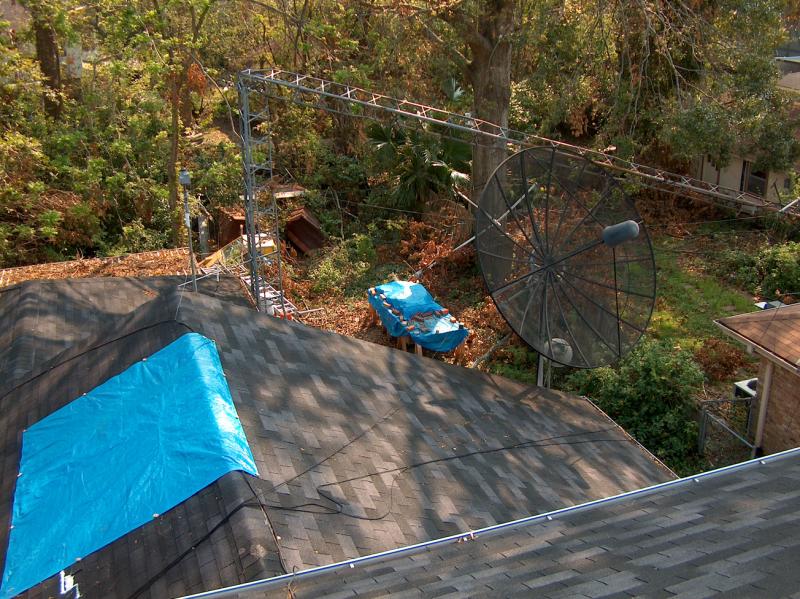
A view from the upper roof of my QTH shows that the tower collapsed to the South. The failure point was at the place where the lowest set of guy lines is attached to the tower structure. The cause of failure was a large Oak tree branch which fell and hit the upper guy lines on the South side of the tower. The stress of the falling branch added to the wind load on the tower at a wind speed of approximately 100 MPH (44.8 Meters/Second) was simply too much for the tower to bear, and structural failure occurred. Due to the rather light weight of the tower, the damage to the neighbors roof was minimal.

This is the upper end of the tower resting on the neighboring rooftop. Notice that the guy lines holding my rooftop tower/mast in place are still there - that structure survived the storm. The remains of my modified W9INN dipole may be seen dangling down in the center of the picture.

This beam will not see the top of a tower again...

The wind whipped some of the Dacron support lines into a tangled frenzy. See the pine straw jammed under the wires on the roof? These came from a couple of pine trees over a block away from the house. On the North side of the roof, I found pine needles driven as far as 8 inches under the remaining asphalt shingles.

Although it was left hanging down draped across the roof, only one of the wires in the W9INN dipole was broken. All the wires are made from # 14 Gauge copper wire.
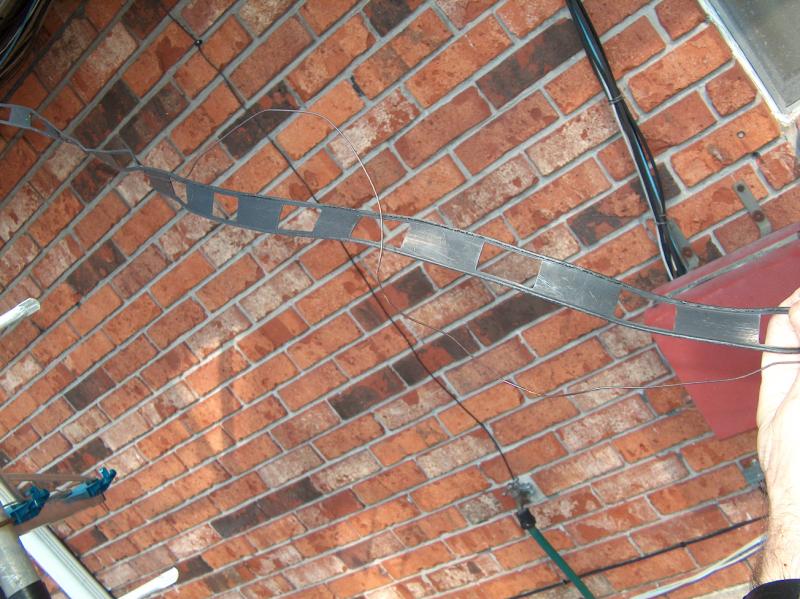
The feedline for the W9INN dipole was severely damaged. It was broken in two places, and the loose ends had the copperweld wires ripped out of the polyethylene jacketing.

A rather amusing side-bar - doves are not known for building the sturdiest nests in the bird world, but the nest built by the family of doves that has nested on top of one of my copper ground straps for the past 8 years did survive the storm quite well indeed. For some reason, the dove chose to build her nest on the South side of the house, where the nest was fairly well protected from the hurricane winds.

A ground view of the rooftop mast assembly. The mast survived OK. The remains of the W9INN dipole are visible draped across the roof. Although it looks as though the television antennas survived as well, in reality the insulators were cracked and split, and the rivets which are necessary for good electrical contact have all vibrated loose. The TV antennas had to be scrapped. The UHF TV antennas were OK. The G6-144 antenna suffered severe mechanical damage as well, and fell apart when I tried to take it down. However, it should be noted that I have had it in the air for almost 30 years!

About half way up and to the right in this photo you can see the top end of the transmitting antenna for WC2XSR/13. It did not break during the storm.

This is the Big Branch that fell and took down the tower. Partially hidden behind the branch is a 6 foot diameter microwave antenna. In the upper left of the picture you can see the remains of my 10 foot diameter low frequency loop antenna. It was damaged when another branch fell on it and smashed it against the wood fence.
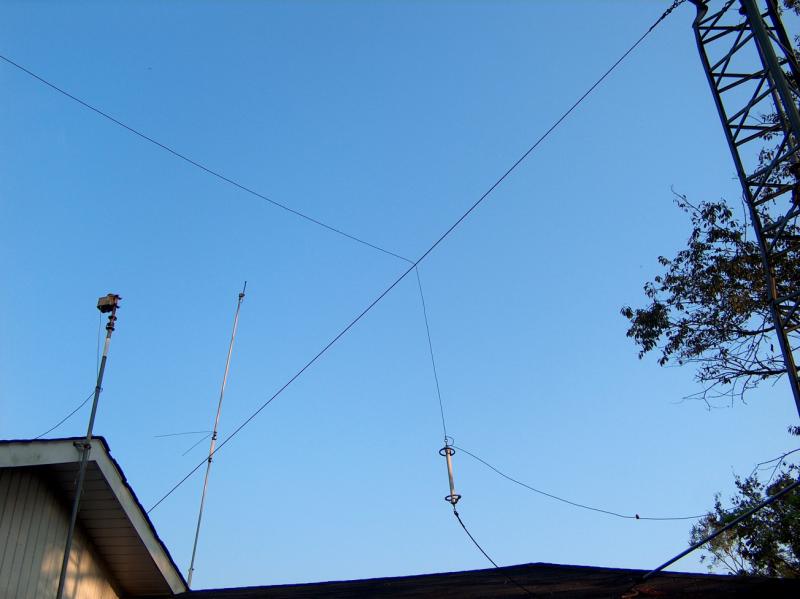
This is the lower end of the transmitting antenna for WC2XSR/13. The upper end is still attached to the top of the tower, now resting on my next door neighbors rooftop.

This is the butt end of the Big Branch that snapped off during Katrina and fell on the tower guy lines, bringing down the tower. It's not very impressive looking, to have done so much damage!

This was the East end of my modified W9INN dipole antenna. It it still connected to the fallen tower. I was able to remove and salvage this antenna. However, after many years of exposure to sunlight and the elements, the loading coils will require replacement or repair before reinstalling the antenna.

Looking up the South side of the tower at the failure point. Note that the tower failed at the lower guy wire connection point.

The Big Bend. The center pipe was connected to the TH-3-jr beam atop the tower. The antenna rotor was located at the bottom of the tower, and this pipe rotated the beam. The pipe is made from 1-1/4" water pipe. It bent like a garden hose when the tower collapsed.

The rooftop tower survived the storm quite well. I had calculated that the failure point would be somewhere above 125 MPH. The winds in Katrina at this QTH did not reach that velocity. The pipe supporting the G6-144 antenna was bent at the base by the force of the winds.
The 2.4 GHz antenna seen on the mast above the TV antenna was forced about 20 degrees counterclockwise by the wind. The mount did not slip on the mast, instead the metal mount actually bent from the force applied to it. The reflector assembly on the antenna is made of cast aluminum gridding, and it was warped out of shape by the wind. Wind vibrations also cracked several of the grid sections, so the reflector broke in two as soon as I attempted to bend it back into the correct shape.
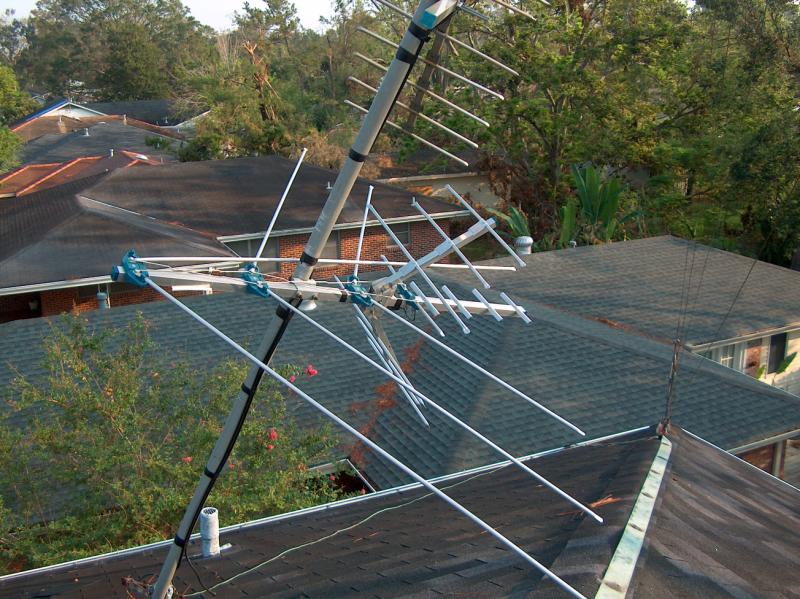
The TV antennas look in fairly good shape, but most of the insulators are cracked, and the rivets have worked loose, causing intermittent electrical contact between the element sections.

One of the high voltage antenna insulators for the transmitting antenna of WC2XSR/13 is seen laying on the roof where it fell during the storm. The impact of the landing caused the anti-corona rings to collapse.

Looking down at the Big Branch that fell on the tower guy lines and caused the tower to collapse. My damaged LF loop antenna can be seen laying across the wooden fence.

The laid-low Low Frequency loop antenna.

A view to the West of the failure point on the tower. Notice the tree branch caught in the tower bracing. It was blown there during the hurricane.

A closer look at the twisted tower at W5JGV / WC2XSR/13.
73, Ralph W5JGV
[Home]
The entire contents of this web site are Copyright © 2002 - 2006 by Ralph M. Hartwell II, all rights reserved.